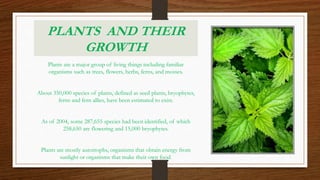
plant and growth
- 1. PLANTS AND THEIR GROWTH Plants are a major group of living things including familiar organisms such as trees, flowers, herbs, ferns, and mosses. About 350,000 species of plants, defined as seed plants, bryophytes, ferns and fern allies, have been estimated to exist. As of 2004, some 287,655 species had been identified, of which 258,650 are flowering and 15,000 bryophytes. Plants are mostly autotrophs, organisms that obtain energy from sunlight or organisms that make their own food.
- 2. WHY THEY ARE IMPORTANT ? • Most plants carry out a process called photosynthesis, which occurs in the chloroplasts of plants .It is a common misconception that most of the solid material in a plant is taken from the soil, when in fact almost all of it is actually taken from the atmosphere. • Through a process known as photosynthesis, plants use the energy in sunlight to convert carbon dioxide from the atmosphere into simple sugars. These sugars are then used as building blocks and form the main structural component of the plant .Plants rely on soil primarily for water (in quantitative terms), but also obtain nitrogen, phosphorus and other crucial elemental nutrients. For the majority of plants to grow successfully they also require oxygen in the atmosphere (for respiration in the dark) and oxygen around their roots.
- 3. WHATS PHOTOSYNTHESIS ? Plants need food to respire, grow and reproduce. Unlike animals, plants are able to make their own food by the process of photosynthesis. Photosynthesis takes place in the part of the plant cell containing chloroplasts , these are small structures that contain chlorophyll. For photosynthesis to take place, plants need to take in carbon dioxide (from the air), water (from the ground) and light (usually from the sun).
- 4. PROCESS OF PHOTOSYNTHESIS • During photosynthesis, molecules in leaves capture sunlight and energize electrons, which are then stored in the covalent bonds of carbohydrate molecules. That energy within those covalent bonds will be released when they are broken during cell respiration. How long lasting and stable are those covalent bonds? The energy extracted today by the burning of coal and petroleum products represents sunlight energy captured and stored by photosynthesis almost 200 million years ago. • Plants, algae, and a group of bacteria called cyanobacteria are the only organisms capable of performing photosynthesis. Because they use light to manufacture their own food, they are called photoautotrophs (“self-feeders using light”). Other organisms, such as animals, fungi, and most other bacteria, are termed heterotrophs (“other feeders”) because they must rely on the sugars produced by photosynthetic organisms for their energy needs. A third very interesting group of bacteria synthesize sugars, not by using sunlight’s energy, but by extracting energy from inorganic chemical compounds; hence, they are referred to as chemoautotrophs. •
- 5. CARNIVOUROUS PLANTS ? • Carnivorous plants are plants that derive some or most of their nutrients (but not energy, which they derive from photosynthesis) from trapping and consuming animals or protozoans, typically insects and other arthropods. Carnivorous plants have adapted to grow in places where the soil is thin or poor in nutrients, especially nitrogen, such as acidic bogs. Charles Darwin wrote Insectivorous Plants, the first well-known treatise on carnivorous plants, in 1875.[4] Carnivorous plants can be found on all continents except Antarctica, as well as many Pacific islands.[5] • True carnivores is thought to have evolved independently nine times in five different orders of flowering plants and is represented by more than a dozen genera. This classification includes at least 583 species that attract, trap, and kill prey, absorbing the resulting available nutrients .This number has increased by approximately 3 species per year since the year 2000 .Additionally, over 300 protocarnivorous plant species in several genera show some but not all of these characteristics.
- 6. THANKS FOR WATCHING and REMEMBER, SAVE PLANTS
